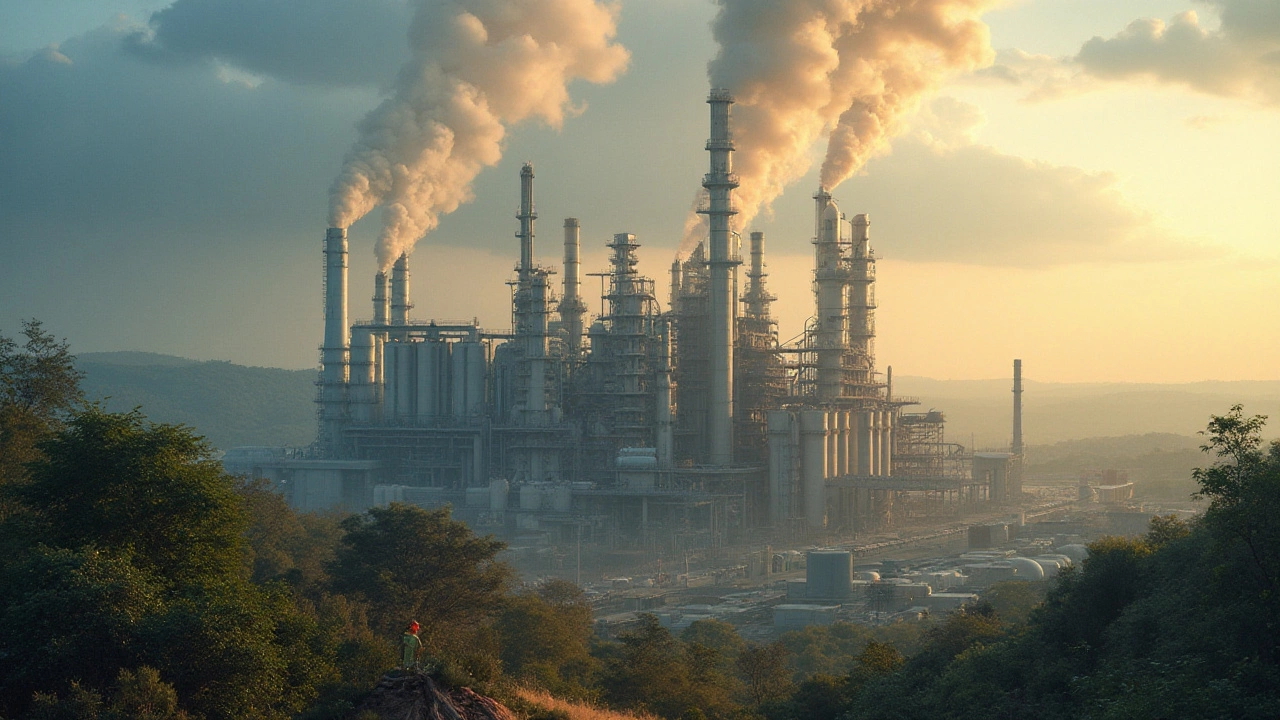Sulfuric acid, a name that resonates with immense utility and industrial prowess, stands tall as an indispensable chemical in India. Labelled as the 'King of Chemicals,' this compound holds a commanding presence in various sectors, influencing both daily life and sophisticated industrial processes. Despite its straightforward composition, sulfuric acid plays versatile roles that call for a deeper exploration of its importance.
Whether it's the nourishing of crops or the facilitation of large-scale manufacturing, sulfuric acid is an unsung hero in many industries. Understanding the production and purpose of this chemical sheds light on why it remains a fundamental pillar of India's economy and a crucial driver of its growth.
- Introduction to Sulfuric Acid
- Historical Background
- Production Process
- Applications and Uses
- Economic Impact
- Future Prospects
Introduction to Sulfuric Acid
Sulfuric acid, with the chemical formula H2SO4, has been dubbed the "King of Chemicals" due to its unparalleled utility across a multitude of industries. This powerful compound is characterized by its oily consistency and corrosive nature, making it both a versatile asset and a substance that requires careful handling. As one of the most produced chemicals worldwide, sulfuric acid's importance cannot be overstated. Its role as a critical intermediary in chemical synthesis and industrial processes underscores its vital presence in global economic operations. Sulfuric acid was first referred to as ‘oil of vitriol’ after its discovery in the eighth century by the Persian alchemist Jabir ibn Hayyan, reflecting its longstanding historical significance.
The ubiquitous nature of sulfuric acid hinges on its multifaceted applications, ranging from the production of fertilizers to refining petroleum and processing metals. Fertilizers alone consume nearly 60% of the domestically produced sulfuric acid in India, illustrating its irreplaceable contribution to the agricultural sector. Its role in removing impurities during petroleum refining ensures that fuels and oils meet stringent quality standards. Additionally, sulfuric acid acts as a catalyst in the synthesis of many essential compounds including hydrochloric acid, nitric acid, and synthetic detergents, further cementing its status in the chemical hierarchy.
Leading chemist Dr. Alfred Stetz famously noted, "Where there is sulfuric acid, there is industrial civilization." This quote captures the essence of this remarkable compound and its role as a lynchpin in modern development.
Advanced manufacturing processes rely heavily on sulfuric acid, with its demand consistently rising as industries strive for precision and efficiency. From manufacturing pigments and dyestuffs to optimizing metal processing, sulfuric acid enhances the quality and effectiveness of many materials. Its ability to dehydrate, or remove water from substances, makes it invaluable in chemical reactions that require stringent environmental control. In laboratories around the globe, sulfuric acid is indispensable in chemical analysis and titrations, highlighting its broad scientific relevance. Despite its caustic nature, it is the acid's strength and reactivity that empower a myriad of processes, forming the cornerstone of both raw material production and refined product development.
One particularly intriguing aspect of sulfuric acid involves its role in creating other chemicals within India’s thriving chemical industry. Major chemical manufacturers synthesize phosphoric acid—a precursor for phosphate fertilizers extensively used in agriculture—through a process that requires large volumes of sulfuric acid. The interplay between these chemicals not only supports the agricultural backbone but also contributes to economic stability. The prolific use of sulfuric acid offers insights into industrial growth patterns, and tracking its production allows economists and industrial planners to gauge the expansion of sectors such as manufacturing and agriculture.
As industries evolve, sulfuric acid continues to adapt, reflecting a heritage built on utility and resilience. Understanding its widespread application provides an appreciation for how integral it is to advancements in infrastructure and technology. Whether cleaning residues in steel manufacturing or facilitating modern battery production, sulfuric acid’s extensive reach is felt across continents. With innovations in chemistry and engineering, its usage is set to broaden further, promising sustained relevance in the future landscape of India's chemical domain.
Historical Background
Sulfuric acid's journey through history is as rich and textured as its array of uses in today's world. Dating back to the classical era, it was first known to early alchemists as 'oil of vitriol.' This label reflected the intense fascination and value it held for their pursuits. The transformation of sulfur and similar substances into a powerful acid was akin to a magical ritual, capable of unveiling secrets of matter itself. From these mysterious beginnings, sulfuric acid started its ascent to become the cornerstone it is in the modern chemical industry.
During the Middle Ages, European alchemists not only refined the extraction methods but also widened its application scope, delving deeper into its chemical properties. By the 12th century, Arabic alchemists had documented detailed processes, significantly contributing to the knowledge pool. Their fervent research laid the groundwork for further discoveries and innovations in the later centuries. The industrial revolution witnessed sulfuric acid evolving from an arcane relic of alchemical study to a staple in burgeoning industries. Gottfried Wilhelm Leibniz, a towering intellect of the 17th century, even remarked on its chemical prowess in his own philosophical musings.
"Such an element, like the sulfuric acid, bridges the realms of curiosity and utility," noted Liebniz, capturing its essence perfectly.
The 18th century saw the famous lead chamber process invented by John Roebuck, which marked a significant milestone in mass production. This breakthrough technique revolutionized the manufacturing capabilities, allowing for widespread, economical production. The contact process improvement further refined this efficiency in the early 20th century, underlining its vital role in the rapidly expanding industrial landscape of that time. Fast-forwarding to the 21st century, chemical manufacturers in India and beyond continue to rely heavily on the production and application of sulfuric acid, essentially following the same fundamental principles while embracing technological advancements that enhance efficacy and environmental sustainability. India, a burgeoning chemical powerhouse, appropriately regards sulfuric acid's lengthy history as a testament to its unrelenting utility and essential status.

Production Process
The production of sulfuric acid, often termed the 'lifeblood of the chemical industry,' is an intricate yet fascinating journey that underscores its prominence as the king of chemicals. At the heart of this process lies the Contact Process, a method that has transformed sulfur dioxide into the acid with exceptional efficiency. The process begins with the burning of sulfur or sulfide ores, leading to the production of sulfur dioxide, a key precursor in this synthesis. The role of oxygen is pivotal here, as it catalyzes the conversion of sulfur dioxide to sulfur trioxide within a vanadium(V) oxide catalyst bed housed inside towering industrial reactors.
Once sulfur trioxide is generated, the next step involves its absorption into water. However, simply adding it to water would create a violent reaction, so instead, it is dissolved into existing sulfuric acid, which prevents any hazardous exothermic reactions. What emerges from this complex dance of elements is oleum, also known as fuming sulfuric acid. By carefully diluting oleum with water, manufacturers produce concentrated sulfuric acid typically used in various applications. Interestingly, the elegance of this method lies in its cyclical nature—what begins as raw sulfur or sulfide ores transforms imperceptibly into a formidable compound, crucial to myriad industries from agriculture to mining.
The significance of sulfuric acid's production process is echoed in global outputs. A quote by renowned chemist John Emsley captures its essence:
"Without sulfuric acid, the modern world as we know it would grind to a halt. Its production stands as a measure of industrial capacity and economic vitality."Indeed, India stands among the top producers of this chemical, leveraging this capability to fuel key sectors, thus fortifying its own economic landscape.
Balancing environmental considerations with industrial needs, manufacturers have innovated to reduce emissions associated with sulfuric acid production. Advanced scrubbing technologies and upgraded catalyst systems aim to minimize sulfur dioxide emissions, reciprocally enhancing air quality and adhering to stringent environmental regulations worldwide. Notably, with rising awareness towards sustainable practices, the Indian chemical manufacturing landscape is embracing greener technologies. This shift not only acknowledges the ecological impact but also secures a competitive edge in international markets that increasingly demand sustainability.
Stepping towards the future, the relentless need for sulfuric acid propels research and development initiatives, sparking innovations aimed at optimizing yields and energy efficiency during production. Employing state-of-the-art predictive analytics and automation technologies, manufacturers can streamline the Contact Process, reducing energy consumption and minimizing waste. It promises an exciting trajectory for the industry, one that blends technological advancement with sustainable protocols to meet burgeoning global demands while respecting our environmental boundaries.
Applications and Uses
Sulfuric acid, often referred to as the workhorse of the chemical industry, finds its place in an astounding array of applications. Its reactivity and commercial viability make it a backbone for many industrial processes. In agriculture, sulfuric acid plays a crucial role in the production of fertilizers like superphosphate, nourishing fields that feed billions. Few realize that every abundant harvest owes a debt of gratitude to this fundamental compound.
Beyond farming, one encounters sulfuric acid in everyday products such as batteries, where it serves as an electrolyte in lead-acid batteries, powering vehicles across the globe. This ability to store and distribute energy succinctly illustrates why the acid is dubbed the lifeblood of the modern economy. The manufacturing sector, too, leans heavily on sulfuric acid, utilizing it in the production of plastics, synthetic rubber, and fibers—materials that construct our everyday world.
"Sulfuric acid is to the chemical industry what steel is to heavy industry," remarked a renowned industrial chemist.
The purifying capability of sulfuric acid is noteworthy, particularly in oil refining processes where it removes impurities, enabling the extraction of cleaner fuels. The metals industry relies on this acid to treat metals like copper and zinc, facilitating everything from construction to electronics. Even in our daily lives, we unwittingly benefit from its applications, as it aids in creating detergents and cleaning agents, keeping our environments pristine.
Application in Pharmaceuticals
A less visible but equally critical role of sulfuric acid lies in the pharmaceutical industry. From the synthesis of active ingredients to chemical laboratories conducting research, this acid's involvement is indispensable. The medical field relies on accurate solutions facilitated by sulfuric acid for various procedures, highlighting its quiet yet significant importance in healthcare.
Statistical data reflects that India produces millions of tons of sulfuric acid annually, underscoring its indispensable role in the national economy. In 2022, for instance, India saw a production increase by 5%, reflecting growing demand across industries.
Chemical manufacturers in India harness this compound not just for domestic use but also to meet international market demands, emphasizing its role as a strategic resource. This is a testament to its versatile nature and ever-present demand in the interconnected web of industrial processes. As sectors continue to innovate and expand, particularly with the global push towards sustainable solutions, the role of sulfuric acid is only set to grow.

Economic Impact
The economic impact of sulfuric acid in India is enormous and touches various facets of the nation's industrial tapestry. Occupying a vital role in the chemical industry, sulfuric acid is seen as a critical driver of economic growth and industrialization. This versatile compound is key to several major industries, such as fertilizer production, metal processing, petroleum refining, and chemical synthesis. Fertilizer production alone forms a substantial portion of its demand, as sulfuric acid is used in the manufacture of phosphate fertilizers, which support India's massive agricultural sector. The agriculture industry in India relies heavily on these fertilizers to maintain crop yield, feeding millions and boosting the agro-economy.
In the process of steel manufacturing, sulfuric acid plays an essential part in pickling, a chemical method used to remove impurities, such as rust and scale, from the surfaces of steel, thus enhancing the product quality. The contribution of this chemical is also significant in sewage treatment plants, where it handles challenging waste to ensure environmentally sustainable waste management practices are in place. Moreover, sulfuric acid's role in petroleum refining, where it is used to produce alkylate, a key component in automotive fuel, makes it indispensable to the energy sector. This interlinks the chemical with the nation’s energy security and mobility sector, affecting both public and private transportation.
The financial implications of sulfuric acid extend to generate employment opportunities and supporting related industries. By 2023, India stood as one of the largest producers and consumers of this chemical, forming a significant segment of its chemical production capacity, which accounts for nearly 80% of acids produced in the country. Investment in sulfuric acid infrastructure and technology not only fortifies production capacity but also boosts India's export potential, making it a global player in the chemical market. According to the Indian Chemical Manufacturers Association, the sulfuric acid sector contributes billions to the economy, underlining its significance.
"Sulfuric acid's foundational role in multiple manufacturing sectors underscores its importance," remarked a leading industry analyst.This positions sulfuric acid as a robust financial pillar within the chemical industry and the Indian economy.
Finally, the economic ramifications of sulfuric acid are anticipated to expand even more in the future, as green technologies and sustainability efforts evolve. Innovations in areas like renewable energy and advanced material processing where sulfuric acid is a key component, point to a promising horizon of eco-friendly industrial applications. Investment in research and development to mitigate environmental impact and improve efficiency can further leverage the economic benefits of sulfuric acid, ensuring that it retains its title as the 'King of Chemicals' well into the future.
Future Prospects
The future of sulfuric acid in India’s chemical landscape presents a dynamic and promising outlook, as numerous factors suggest its critical importance is only set to grow. As one of the nation's most pivotal industrial chemicals, the demand trajectory for sulfuric acid continues to follow an upward curve. This growth isn't just tied to India’s booming population but also to the modernization of its agricultural practices and industrial sectors. Farmers increasingly rely on fertilizers that utilize sulfuric acid to ensure robust crop yields, a trend that highlights its role in revolutionizing India's approach to sustainable feeding of its billions. Meanwhile, industries focusing on metal processing, petroleum refining, and the manufacture of chemicals continue to consume vast quantities of this chemical, cementing its status as the lifeblood of varied production processes.
The Indian government’s ambitious industrial policies and environmental regulations also shift the dynamic positively toward more environmentally friendly production methods, potentially increasing the usage of sulfuric acid. Driven by a need to meet stringent environmental standards, industries are investing in cleaner technologies that dovetail with sulfuric acid's chemical properties. Looking forward, analysts predict a steady 4% annual increase in the chemical’s demand, reflecting the intertwined growth of the industries it supports. Significant workforce training initiatives and technological advancements further pave the way for maximizing the efficiency and output of sulfuric acid production—a crucial strategy to keep pace with its expanded uses in industries previously untapped. Quoting a report from the Chemical Industry Digest, an expert noted, "Sulfuric acid isn’t just a chemical; it’s the backbone of industrial innovation."
Moreover, global collaborations and trade negotiations are essential to align sulfuric acid production in India with international trends and needs, ensuring it remains competitive. These interactions can facilitate sharing new technological advances that decrease the carbon footprint of sulfuric acid production, making it not only economically viable but also environmentally sustainable. The government is also strategically investing in infrastructure to support improved logistics for transporting sulfuric acid, which can often be challenging given its hazardous nature. Export markets are kept in sight, as India's stature as a significant player in the global chemical market gives an added impetus to optimizing chemical manufacturers across the board. Comprehensive strategies around enhancing domestic production capabilities are being coupled with policy supports to ensure a balance between supply and environmental considerations. Advancements such as the development of recyclable materials and better safety protocols form part of the key focus areas for the future, ensuring that sulfuric acid remains the workhorse of industry without sacrificing safety and ecological integrity.

